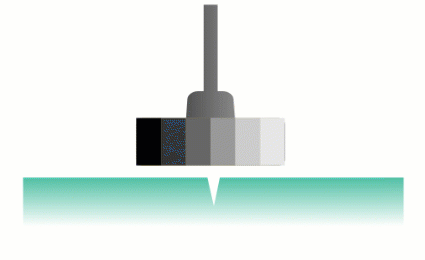Your beautiful glass tabletop got scratched by a careless guest or annoying nephew. As the sun shines across the table the scratches annoy you. Can anything be done? Find out how to fix a scratched glass tabletop in this post from the glass professionals at Artistry in Glass
Don’t waste time with home remedies like toothpaste – if you can feel the scratch you’ll need professional help – for light scratches, cerium oxide works best.
As an Amazon Associate, I earn from qualifying purchases
Table of contents
How does glass get damaged?
Glass is harder than wood or plexiglass but it is still easily scratched. Having a perfectly homogeneous and reflective surface, a scratch on glass often appears more visible and annoying than scratches on other materials.
Glass is scratched by hard sharp objects
A glass tabletop gets a deep scratch when the surface is scraped by a hard and sharp object.
By “hard”, we mean harder than glass on the Mohs scale (for example porcelain). Jump to this section for a full explanation of Mohs scale of hardness.
So glass gets scratched by hard objects, but it is important to understand that the material must also be sharp to create a significant scratch. Notice, in the image below, that a smooth china mug, although harder than glass, will glide over the glass tabletop whereas a rustic stoneware mug with rough edges can leave serious scratches.
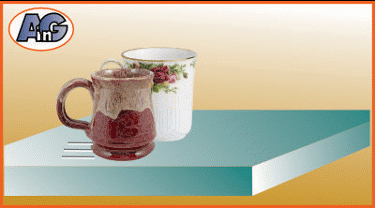
Serious scratches: household culprits
The main household culprits are china, porcelain, pottery (Mohs hardness 6-7), and some cutlery (hardened steel knives), as well as very hard materials like gemstones (diamond, ruby, sapphire, and emerald for example). Another important cause is fine dirt or grit on the surface of tableware.
To avoid scratches always use placemats, runners, or tablecloths on your beautiful glass table. Jump to this section for tips on care of glass tabletops.
Jump to this section to learn how to polish out deep scratches.
Fine scratches: paper towels
It may seem counter-intuitive but polishing glass with a household paper towel can result in fine scratches. Paper is obviously much softer than glass, but very small grains of grit or sand, caught in the paper, can rub against the tabletop and damage the surface.
So to avoid scratches always use a microfiber cloth – the soft fibers will not carry abrasive grit impurities to damage your glass.
Specially designed for polishing glass, these Mr. Siga ultra-fine microfiber cloths come in a pack of 12 and measure 13 3/4″ * 15 3/4″
Surface damage – scuffs
Even materials that are softer or equal in hardness to glass can cause damage to your glass tabletop – without actually creating a scratch. Scraping a drinking glass, for example, across your glass tabletop can cause scuff marks that are permanent and unsightly but can often be repaired by polishing.
Scuff marks are not scratches but, technically speaking, are made up of microscopic, non-elastic dislocations on the surface of the glass. They can often be polished out using cerium oxide with the method explained in this post.
Brittle dislocations – dings
If a heavy object is dropped on an annealed glass tabletop, the most likely result is that it will crack. However, if the glass is thick (1/2″ or 3/4″) and if the impact point is away from the edge, then a small crater-like ding is the result.
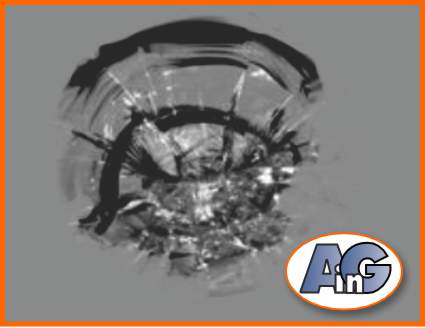
A ding is analogous to a geological impact crater with radial and concentric fracture and sometimes finely pulverized glass powder.
The internal dislocations are deeper than they appear and are therefore hard to polish out. The best method is to use the windshield repair method of filling with special clear resin.
Edge damage – chips
If the edge of your glass tabletop is impacted by a hard object the most common damage is a chip.
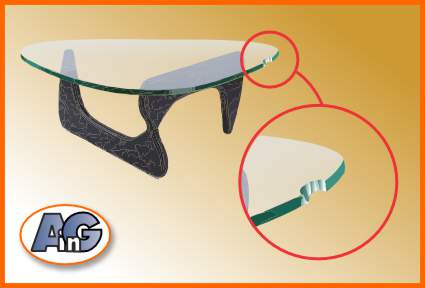
A chip is unsightly and somewhat dangerous because of the sharp edges. It is also, unfortunately, difficult to fix. The best method is to completely grind and polish the chip away but this can only be done with professional tools and even then a new tabletop is often the more economical solution.
Jump to this section for suggestions on how to repair chips.
Study this post for complete information on the problem of chipped glass tabletops.
Removing scratches
Important advice!
The most important advice is not to waste your time with folk remedies. There is an extraordinary tendency for bloggers to recommend the use of household products that are commonly available in the kitchen or bathroom. These products include toothpaste, metal polish, baking soda, oven & denture cleaner, and many others.
These ideas reflect the archetypal female heroine of the American frontier who is frugal and resourceful – surviving the savage forces of the wilderness against all odds – and, in the modern context battling household misfortunes with creative, homespun solutions.
Unfortunately, household products like toothpaste are completely ineffective except for the very slightest scratches – they are a waste of time and effort.
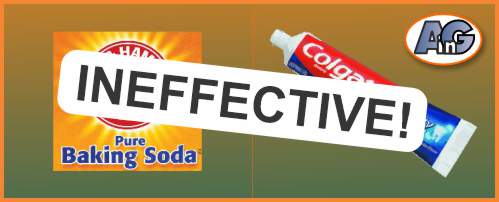
These days, the most specialized tools and materials are available, often for next-day delivery, from Amazon, so there is no need to fall back on wacky household remedies. Read on to learn about the best ways to fix scratches.
.
How to remove a light scratch or scuff
A shallow or light scratch is one that you cannot feel with your fingernail. Obviously, even within this category, there is a spectrum of damage from very minor to ones that are almost deep enough to feel.
For minor scratches
For minor scratches – don’t bother with home remedies like toothpaste – go straight to the abrasive used by professional glaziers – cerium oxide in a slurry applied with a felt pad in a hand drill. The following kit is available on Amazon:
Glass polishing kit comprising buffing pads, sanding discs with a backing pad, and drill adapter for hand drill.
Together with the felt polishing pads, you will need to order cerium oxide like this brand from the Gordon Glass Company®.
Gordon Glass® cerium oxide high-grade polishing powder – 8 oz bag is plenty for numerous scratches.
Procedure for cerium oxide polishing
Make a thick paste of cerium oxide and water and coat your felt or foam wheel. Keep the mixture moist and apply the rotating felt pad to the glass surface. The process actually works best if heat is generated so, taking care, gradually apply increasing pressure to the revolving pads.
We find it useful to mark the work area with a black felt-tip pen to identify the places where scratches remain as the work progresses.
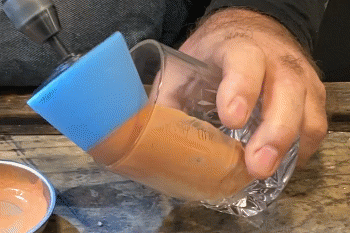
The animation above shows a foam pad with cerium oxide slurry polishing a crystal glass. The same method should be used, with felt or foam pads, on a glass tabletop. Patience is required but, eventually, the fine scratches will disappear.
How to remove a deep scratch
The short answer – don’t try this at home!
Any scratch you can feel with your fingernail can be characterized as deep and is difficult for the amateur to remove. The images below show the process of removing a scratch in diagrammatic form.
The hopeful scratch remover will always be surprised by the depth of what looks like a minor scratch. To make it disappear you have to grind an oval-shaped depression surrounding the damage. This is done using coarse grit on a grinding pad or with wet and dry sandpaper on a drill attachment.
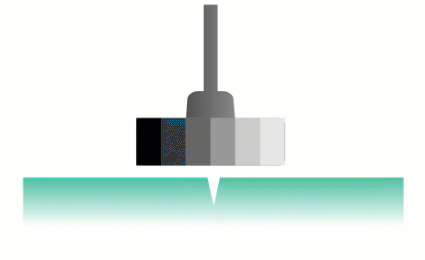
After the bottom of the scratch is reached, you will be left with an oval crater of frosted glass that needs to be pre-polished with a series of gradually finer grits until the final polish can be done with cerium oxide.
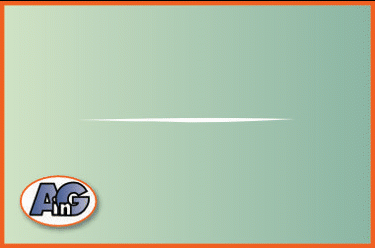
The image above exaggerates the issue slightly – in practice, it is possible to feather the edges to create a gentler depression. However, this will take much longer and cost more and the result is still not a perfect repair – it will show up as an unsightly dip in the glass, especially in bright sunlight.
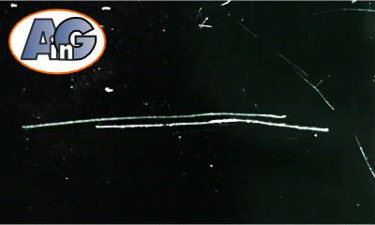
There is nothing magical or mysterious about polishing out a scratch. First, it is necessary to grind/polish the glass down to below the level of the scratch.
For maximum efficiency choose a grit of sandpaper or other abrasive that is equal or slightly higher than the “grit” size of the scratch. For example, the double scratch in the animation below is the type of damage that would be caused by a 200 grit grain of sand. So the first grind stage (show below) is done with #320 grit sandpaper.
Notice that, even after considerable sanding, the scratch is still visible.
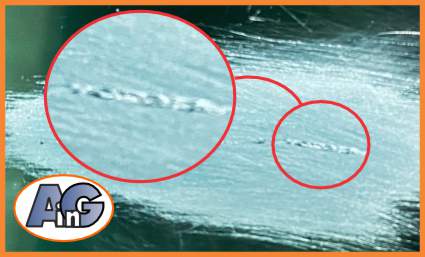
The next stages are to feather out the sanding using progressively finer grits until you get to s fine #5000 grit frosted finish that can be polished with cerium oxide. Learn about sandpaper grits here.
You can imagine that this is a labor-intensive and difficult process: this leads to our recommendation to either put up with the scratch or purchase a new tabletop.
Conclusion for deep scratches
Our recommendation after more than 35 years of experience is that, if a deep scratch is very annoying to you, it is better to purchase one new tabletop. Even with the most heroic efforts, the scratched area will still show – if not with a slight scratch, then with a depression.
If you decide to purchase a new tabletop – study this post before you buy!
Fixing chips on the edge of a glass tabletop
If you cannot polish the edge to remove the chip (ask your local glass retailer if this is possible), then three alternate methods are possible:
- Glue the chip back in place
- Fill the chip with resin
- Smooth the sharp edges with sandpaper
Gluing back a chip
If the chip is simple and no pieces are missing, it is possible to glue the glass back using a special type of UV-activated glass adhesive. Follow this link to find the best glass glue on Amazon.
In practice, this is seldom a good solution because most chips are made up of multiple small fragments and small pieces of glass are likely to be missing.
Fill the chip with resin
This is the method that is well-known for fixing windshields in cars that have been struck by gravel. It is a possible solution and future articles will explain it in more detail.
The main problems are that the resin does not have the same optical properties as glass (specifically the RI – refractive index) is different. Also, the surface of the hardened resin has to be smoothed and polished to be level with the glass and equally reflective.
Our experience is that most detail-oriented homeowners are looking for a perfect result and are not happy with a resin-filled repair because it is not invisible.
Smooth the sharp edges
As a stop-gap solution, homeowners can take the sharp edges off of a chip by sanding with fine sandpaper (go down through the grits from #220 to #800).
An affordable nail file will also do the job. This set from Amazon contains three grades of abrasives.
After smoothing the sharp edges, touch up the frosted surfaces with clear nail polish
The glass workers’ secret weapon: clear, glossy nail polish fills the sanded surface to restore the shine to frosted glass. Any gloss polish will do as long as it is clear.
Conclusion on chipped edges

Like deep scratches, bad chips are, generally speaking, very hard and expensive to fix. Be prepared to purchase a new tabletop. Follow this link to get the best prices on glass.
How to avoid scratches
As this post has shown, damage to your glass tabletop is not simple or inexpensive to repair. Most serious scratches, dings, and chips cannot be fixed to the satisfaction of the persnickety homeowner and the only alternative is to purchase a new top.
With this in mind – try to follow these tips to avoid tabletop damage:
Always use placemats
Regular household china is harder than glass and sharp rustic pottery is even more dangerous. So always protect the surface with coasters or placemats or tablecloths.
Clean with care
Don’t use abrasive pads or cleaners – you will produce fine scratches that will turn the glass cloudy. Make sure to clean outdoor tables regularly to prevent the buildup of hard water stains caused by the evaporation of water. To get rid of cloudy glass – study the tips in this post.
Beware of sharp corners
Purchase tables with rounded corners if you can afford the extra cost.
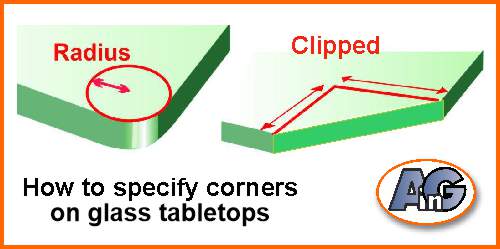
Glass companies prefer to cut square corners because they need less labor. However, sharp corners are easy to chip and can also be dangerous if you have kids running around the house.
Mohs scale of hardness
The table below compares Mohs scale for minerals with the hardness of materials commonly found in the home. Note that the scale is not linear: for example, corundum (hardness=9) is twice as hard as topaz (8), but diamond (10) is four times harder than corundum.
The important takeaway from the table below is that a material with higher hardness will scratch a material with lower hardness. So a glass tabletop (hardness 5.5) can be scratched by pottery, porcelain, and hardened steel knives in addition to jewelry like diamonds, topaz, rubies, and emeralds.
Mohs Hardness Table
| Mohs Hardness | Material | Common name |
| 1 | Talc | Baby Powder |
| 2 | Gypsum | Plaster of Paris |
| 2.5 | Sodium Bicarbonate | Baking Soda |
| 3 | Calcite | Marble/limestone |
| 4 | Fluorite | Calcium fluoride |
| 5 | Apatite | |
| 5.5 | Glass | Window/table glass |
| 5.5 | Steel | Knife blade |
| 6 | Orthoclase | Feldspar |
| 6 – 7 | Porcelain | Pottery |
| 6 – 8 | Hardened steel | Steel file |
| 7 | Quartz | Amethyst/Citrine |
| 8 | Topaz | |
| 9 | Corundum | Ruby/sapphire |
| 10 | Diamond |
Notice also that the severity of the scratch depends on the sharpness of the material – so a smooth hard object will slide over the surface of your tabletop without making a scratch. Also, a slightly softer object or one of equal hardness can damage the tabletop surface creating a “scuff” rather than a true scratch.
Grit sizes for sandpaper
Sandpaper or wet & dry emery paper is available in numerous grit sizes on Amazon. Purchase fine sheets for hand polishing here. Or choose discs for serious polishing on a sanding machine
| Grade | Description | USA #Grit | Used for |
|---|---|---|---|
| Ultra fine | Final pre-polish before cerium oxide | 2000 to 10000 | Final pre-polish |
| Very fine | Medium fine pre-polish | 800 or 1000 | Pre-polish |
| Fine | Secondary grit for deep scratches | 400, 500 or 600 | First pre-polish |
| Medium fine | Starting grit for most deep scratches | 360 or 320 | grind down to the scratch depth |
| Medium | Emergency grit for very coarse scratches | 240 | grind down to the scratch depth |
Useful products for glass cleaning
In our nearly 40 year’s experience in the glass business, we have identified two indispensable products for the removal of cloudiness in glass or crystal. First: study this post to figure out if the cloudiness is caused by hard water stains or by permanent etching. Then, choose from our recommended products below:
Water spot remover
Do not waste your time with vinegar, CLR, acetone, oven cleaner, rubbing alcohol, or other wacky household remedies – for hard water stains – use this guaranteed professional water-stain remover:

Glass tabletops & shelves – info from Artistry in Glass
- Benefits of glass shelving – info from experts!
- How much do glass tabletops cost?
- Do glass shelves need to be tempered?
- What is the best thickness for glass shelves?
- Best edge type for glass shelves, polished or beveled?
- How much weight can a wall shelf carry?
- What color glass should my shelves be?
- Glass tabletops – 10 amazing benefits explained
- How to order a glass tabletop
- Best thickness for glass tabletops – expert advice
- Should glass tabletops be tempered?
- Should glass tabletops be beveled?
- How to paint a glass tabletop
- All about tempering glass tabletops!
- How to tell if your glass is tempered
- Can tempered glass be cut?
- How to protect your wood table with glass
- How to fix a scratched glass tabletop
- How to fix a chipped glass tabletop
- How to replace broken patio table glass
- How to measure for a glass tabletop
- Video – how to measure your tabletop
- Plexiglass vs glass – pros and cons
- Beveled glass table base – a case study
- Choosing between tempered & laminated glass
- Glossary of terms used in the glass business

